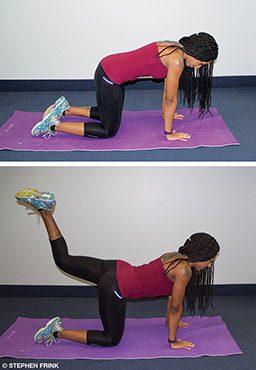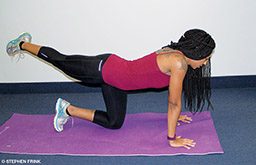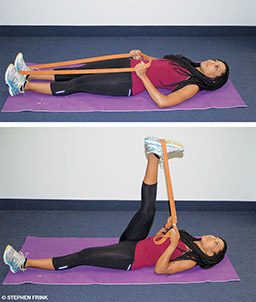You rely on your knees for most of your daily activities, and this use adds up over time. Simply walking up stairs, for example, increases the pressure on your knees by up to four times your body weight. Knee pain can cause discomfort when climbing a ladder, doing a frog kick or just standing up in full gear. It is important to keep your knees healthy to reduce the chances of knee pain negatively affecting your diving.
Proper maintenance, including stretching, strengthening and mobility exercises, can facilitate movement and alleviate pain. The same training principles apply to people recovering from minor knee discomfort and those seeking to prevent knee pain.
Remember, it took your lifetime to get to this point with your knees. So take it slow, and always listen to your body. If an exercise hurts, stop. The pain could be because of improper form, which you can correct, but there may be an underlying cause.
Knee pain can have a variety of causes, so if you have pain consult your doctor or physical therapist to determine if these exercises are right for you.
In the age of technology, society as a whole suffers from weak butts. Weak glutes put more stress on the knees and ankles. Weak abs promote an exaggerated lower back curve that causes knees to roll inward. A strong core promotes healthy spinal alignment, reducing stress on your knees.

The following exercises target your glutes and core. Complete one set of each exercise initially, and progress up to three sets of each. Allow at least one day of rest after performing these exercises before trying them again.
Bent-Leg Kickbacks
- Get on all fours on a soft surface, with your knees under your hips and your wrists under your shoulders (table-top position).
- Lift one leg behind you while keeping your knee bent.
- Lower the leg to just before your knee touches the ground, and repeat.
- Complete 10-20 repetitions, and switch legs.
Straight-Leg Crossovers
- Start in table-top position.
- Extend one leg (hip and knee) straight behind you; this is the leg you will be working first.
- Lift the leg as high as you can, and cross it laterally over your foot on the ground.
- Lift the leg as high as you can, and return it back over your foot to the position in step two.
- Complete 5-20 repetitions, and switch legs.

Tips:
- Maintain tight abdominals to keep your trunk in a table-top position.
- Fold a mat or towel under your knees and/or the palms of your hands to alleviate pressure as needed.
Challenge: Try to hold the highest position of each repetition for 2-3 seconds.
Unfortunately, as we age we lose flexibility. Reduced flexibility has a direct impact on mobility and can lead to knee pain. Fortunately, this is reversible.
It is important to stretch the muscles surrounding your knee every day, if possible. You can stretch the muscles that support the front, back and sides of your knees. The most common sources of tightness, and therefore pain, are on the lateral side (outside) and back of the knee.

The following exercises stretch the muscles surrounding your knee and can (should) be done every day.
Strap Hamstring Stretch
- Lie on your back with a towel, strap, belt or rope.
- Place the strap around the arch of your foot, and hold one end in each hand.
- Pull your foot as high as possible, and hold for 20-30 seconds.
- See if you can pull a little farther, and hold for another 10 seconds.
Strap Iliotibial (IT) Band Stretch
- Lie on your back with a towel, strap, belt or rope.
- Place the strap around the arch of your foot, and hold one end in each hand.
- Pull that foot across your body as far as possible, and hold for 20-30 seconds.

Strap Adductor Stretch
- Lie on your back with a towel, strap, belt or rope.
- Place the strap around the arch of your foot, and hold one end in each hand.
- Pull the same foot away from your body as far as possible, and hold for 20-30 seconds.

Tip: Try to keep both hips on the ground. This is particularly important during the IT band and adductor stretches.
Challenge: Move the strap closer to your toes, and you will feel the stretch more in your calves.
NOTE: To avoid an increased risk of decompression sickness, DAN recommends that divers avoid strenuous exercise for 24 hours after making a dive. During your annual physical exam or following any changes in your health status, consult your physician to ensure you have medical clearance to dive.
© Alert Diver — Q4 Fall 2016